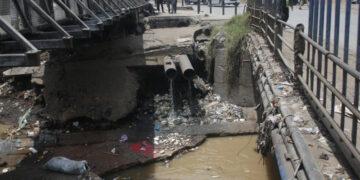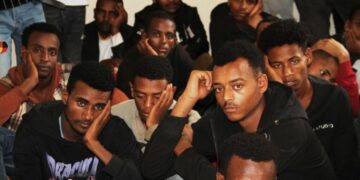When heavy rains sweep through Mount Elgon, the hills come alive — but not in celebration. For many young people in this scenic region, the floods and landslides that follow mean washed-away farms, lost livelihoods, and new fears about a changing climate they barely understand.
“I’ve seen rivers dry up and others overflow,” says Timothy Tumwet, a teacher from Cheptais in Mount Elgon Constituency. “Trees are disappearing, and with them, the water. But all is not lost — people are now planting trees as a personal commitment, and that gives me hope.”
That hope is at the heart of a quiet but growing youth movement in Bungoma County — one determined to redefine how communities think about climate justice, not as a policy phrase, but as a fight for survival and opportunity.
Climate justice links the fight against global warming to social fairness — ensuring that those least responsible for climate change, often the poor and marginalized, are not the ones who suffer most from its impacts.
A new baseline assessment by the Youth Initiative for Land in Africa (YILAA) paints a sobering picture. Despite Bungoma County’s vulnerability to deforestation, droughts, and flooding, only 27.6 percent of young people surveyed could explain what climate justice means.
“Youth have energy, passion, and ideas — but we found they are rarely included in decisions that affect their lives,” said Innocent Antoine Houedji, YILAA’s Executive Director from Benin. “We cannot talk about agriculture, biodiversity, and climate without talking about land. When young people don’t have land security, they can’t act.”
In Bungoma’s rural areas, many young people are eager to take action but face barriers that go far beyond awareness. Land ownership, financial hardship, and deep-rooted gender norms all play a role.
“I want to plant trees, but I have no land,” says Namusasi Erick Makokha, a 27-year-old from Webuye East. “You can’t just go to someone’s farm and plant trees without permission. Most young people depend on parents or landlords, so it’s not easy.”
The YILAA study, conducted in Webuye East, Mount Elgon, and Cheptais, found that most youth activities — from tree planting to market clean-ups — happen only during special events like Mazingira Day. There are few structured, year-round initiatives that sustain engagement or provide economic incentives.
One of those breaking the mold is Nanjekho Mulati, the Bungoma chapter coordinator for Youth for Sustainable Development. Her group, made up of young men and women aged 18 to 35, organizes regular clean-up drives, school visits, and community sensitization meetings.
“What motivates me is that women and girls bear the heaviest burden of climate change,” she says. “We’ve been socialized to carry this burden — fetching water from farther away, cooking with firewood, caring for families during floods. I want to lift it off for myself and for other women.”
Mulati and her peers are also learning to turn environmental problems into business opportunities. YILAA’s eco-preneurship model trains youth to make and sell products from recycled materials — such as jewelry and handbags from plastic waste — and to venture into sustainable projects like beekeeping and kitchen gardening.
“These ideas help us earn an income while protecting the environment,” says Mulati. “It’s not just about planting trees; it’s about growing livelihoods.”
Kenya’s National Climate Change Action Plan (NCCAP) envisions a future where local communities drive climate solutions. But on the ground, youth say those policies rarely translate into real opportunities.
Deborah Oyugi, YILAA’s Anglophone Countries Manager, says this gap is partly due to limited awareness and tokenistic participation. “In Bungoma, only 27 percent of youth even know the county has a climate policy,” she notes. “Young people are invited to meetings, but their views don’t shape decisions. It’s tokenism — not participation.”
The YILAA baseline report recommends creating a Bungoma Youth Climate Action Network, a platform where youth-led groups, civil society, and government agencies can co-create policies and share resources. It also calls for county-level climate action funds, targeted climate education, and gender-sensitive land reforms — particularly in Cheptais, where women and youth rarely own land.
In Mount Elgon, 25-year-old Joyce Chepchumba says the cultural norms that exclude women from owning land make it harder for them to take part in environmental projects. “It’s natural and cultural that women don’t inherit land,” she says. “But things are slowly changing. Some of us now grow kitchen gardens and use biogas instead of firewood — small steps that make a big difference.”
YILAA’s work highlights how traditional land systems intersect with the climate crisis. Without ownership or secure access to land, young people — especially women — have little power to implement long-term conservation solutions.
“When you don’t have the right to access land, you can’t do much,” says Oyugi. “Climate justice means making land ownership inclusive — because without that, the cycle of poverty and environmental degradation continues.”
Despite the obstacles, YILAA’s approach is slowly bearing fruit. In Bungoma, trained “climate champions” are being equipped to educate others. Each trainee is expected to mentor 15 more youth in their villages, creating a ripple effect of awareness and action.
“Nature is green, and human beings cannot live without the environment,” says Makokha. “Those of us who are trained will go out and teach others how to protect it.”
In Webuye East and Mount Elgon, youth-led initiatives are sprouting — from beekeeping cooperatives to tree nurseries — proving that small-scale efforts can drive real change when communities take ownership.
As the movement grows, the call is for government and development partners to back these efforts with resources and inclusion. “Bungoma is blessed with human capital,” says Oyugi. “We can become a generation that gets it right in climate justice — but only if we equip our youth to do so.”
For now, the seeds of that change are in the hands of Bungoma’s young people — many of them with no land, little money, but a powerful belief that no one is coming to save us; we must save ourselves.
The YILAA Baseline Study (2025) was conducted across Webuye East, Mount Elgon, and Cheptais sub-counties, surveying 1,143 youth aged 18–35 to assess their awareness and engagement in climate justice issues. The study found that 27.6% of respondents demonstrated high awareness of climate justice, while 46.1% had moderate to low awareness, and 26.3% showed no awareness at all.
Key barriers identified included limited access to land, inadequate financial resources, and exclusion from decision-making processes, which hinder youth participation in climate action.
Despite these challenges, the study highlighted significant opportunities for youth engagement through eco-preneurship initiatives, participation in policy forums, and partnerships with NGOs, providing avenues to strengthen climate justice advocacy and sustainable development efforts.




